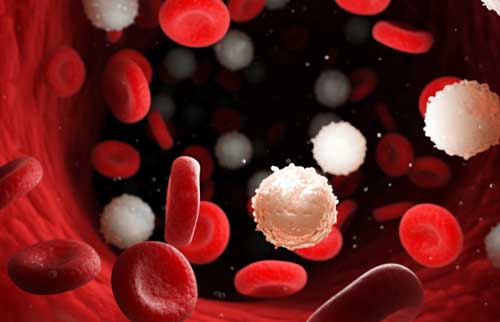Is it possible for a simple blood test to predict, and even prevent, leukemia, lymphoma, myeloma, or other related cancers
It’s a question of intense interest to insurers, clinicians, and patients alike, and for good reason. Blood cancers account for 10% of all diagnosed cancers and, while some are rare, many of the 100 different varieties are among the most costly and deadly diagnoses. They’re also among the most difficult for claims assessors to adjudicate.
Because of the need to treat patients with
increasingly expensive anticancer drugs, many of the millions of
people who are either living with, or are in remission from, blood
cancer face higher treatment costs – and those expenses often do not
return to pre-cancer levels, according to a Milliman study commissioned by
The Leukemia & Lymphoma Society (LLS).
But medical advances offer reason for
optimism. RGA’s Dr. Dan Zimmerman sat down with Dr. Grant Challen, Associate
Professor Department of Medicine, Oncology Division and Stem Cell Biology at
Washington University School of Medicine in St. Louis, to discuss his research. A recent recipient of funding from The Longer Life Foundation, Dr. Challen leads a lab studying ways to identify genes that can be targeted to diagnose blood cancers early – or even recognize the risk before they develop. RGA spoke to Dr. Challen about why blood cancers can be so difficult to treat and what his novel research seeks to accomplish.
Learn more about adjudicating blood cancer claims in PATHFINDER, RGA’s new
professional claims training program in the RGA Global Claims Manual.
PATHFINDER allows you to take control and build your own learning experience by
selecting specific learning modules that are most relevant to each claims assessor's role and needs. Blood cancer is among these online modules and offers
text, visuals, audio, and downloadable material.
Dr. Zimmerman: To understand strategies to prevent disease, we first need to understand causes. What should people understand about how blood cancers develop?
A. Blood cancers are caused by genetic mutations that happen mostly as a consequence of aging. To repopulate our blood and to divide and replicate blood cells, bone marrow stem cells must copy the entire genome and all of the nucleotides of the DNA sequence. In general, this cell machinery does a really fantastic job, but over time, in each cell division one or two mistakes happen across the 300+ billion DNA nucleotides in a genome.
This process resembles making a photocopy. Every time you make a copy there are subtle variations from the original. For the majority of us, these mutations will be inconsequential. They happen in areas of the genome that don't matter or in genes that are not important for those cells to function. Very rarely those errors occur in genes that are critical to the functioning of blood stem cells. When the error occurs in cancer-causing genes, it leads to the cell having what we call a competitive advantage over its normal counterpart cells in the bone marrow, which causes it to grow exponentially and start to overtake the bone marrow. This first stage of blood cancer is called clonal hematopoiesis.
Clonal hematopoiesis is a function of age because every time that stem cell divides, you increase the likelihood of getting a mutation in a particularly important cancer-causing gene. As we age, all of us will develop some level of clonal hematopoiesis with mutations in cancer causing genes. The good news is that for 99.9% of us, it won't matter. We are trying to understand what makes that small fraction of the population who do get blood cancer different from the rest of us who will go on to live normal healthy lives into old age.
Dr. Zimmerman: What role does the environment or family history of cancer play in contracting blood cancers?
A. Only two kinds of cancer are proven to result from external factors – smoking, which causes lung cancer, and sun exposure, particularly ultraviolet rays, which causes melanoma.
We can inherit from familial or family predisposition some forms of cancer. But for the vast majority of blood cancers, I would say for over 95%, contracting these diseases is just bad luck. There's really nothing that an individual can do to avoid this.
Dr. Zimmerman: Talk about your research to stop the progression of blood diseases.
A. Our goal is to identify exactly how specific mutations that occur in important genes in our blood change the fundamental properties of stem cells. These changes lead mutated cells to be able to out-compete normal cells and establish what we call clonal dominance – or clonal hematopoiesis.
If we can drill down and understand the molecular machinery and find pathways that the mutant cells rely on for this increased growth advantage, we can come up with some effective therapeutic strategies to target these stem cells. I think of it as a kind of molecular weed killer, where we are weeding out the cancer-causing cells from the patient’s bone marrow and leaving the normal cells intact.
We really see this as a mechanism for blood cancer prevention, because once the patient ultimately develops acute myeloid leukemia or other forms of blood cancer, that patient becomes really difficult to treat. Blood is a mobile organ. We can't remove it as you can for a solid cancer, and it also evolves very quickly in response to different chemotherapy in terms of developing resistance.
Dr. Zimmerman: Is this treatment or a cure and how expensive is this approach?
A. Rather than trying to develop cures for the fully transformed, mature leukemia, we want to actually stop you from getting to the mature stage in the first place. Blood systems are ideal for this because we can sample blood over time, non-invasively. It's a pretty easy procedure; and sequencing technology is now making this cost-effective.
We know there are really only about 50 important genes and mutations that are responsible for leukemia initiation in people, so the cost of doing this in terms of genome sequencing is becoming more amenable.
Dr. Zimmerman: Does your lab have unique expertise in this research field?
A. Yes, our lab had identified a particular gene that seemed important for stem cell function called DNMT3a. Mutations occur here in approximately 20% of AML cases. Basically this is an enzyme that regulates the epigenome and tells your DNA which genes to express.
We found that this gene was particularly important for blood stem cell function. At the same time as this work from our lab-based studies was being published, sequencing studies at Washington University identified this gene as being one of the most recurrently mutated genes in adults with acute myeloid leukemia. Thanks to support from The Longer Life Foundation, we are now looking for ways to specifically weed out these stem cells with DNMT3a mutations from the bone marrow of people.
Dr. Zimmerman: Do you foresee a day, maybe when we turn 65 and as part of our regular check-ups, we could get a test that might screen us for these abnormalities, and if we're at risk, we could get preventative therapies?
A. That's exactly what we're trying to do with this research. Our goal is to develop these technologies to the point where we know which genes are important. Then we can drill down to a sample size that's amenable to cost-effectively performing genome sequencing. That would allow the physicians to take a couple of drops of blood during a regular annual visit and run that sample over a chip that could detect all important blood cancer causing mutations. Year after year, the physician could monitor levels and be alert to the point when the patient is at risk. That patient could receive preventative treatments.
Dr. Zimmerman: When do you see this being available to physicians?
A. As I mentioned, we're all acquiring cancer-causing mutations in our bone marrow as we age, but the vast majority of people are going to be just fine. It’s in the very rare fraction of individuals who progress from mutations to leukemia. So, two key developments are critical to our making preventative therapies a reality. First, we need to develop a greater understanding of the specific genes in the particular variants that are involved in developing blood cancer, and second, we need to understand the environmental factors and family histories that might separate an individual from the 99.9% of us where mutations don't matter.
These studies are happening now. We are looking at retrospective analysis of epidemiological cohorts in patients whose samples have been banked for a number of years – even decades. We are determining which of those patients developed blood cancer. We can then backtrack and analyze what might have happened for each cancer patient that resulted in that person developing leukemia, for example. We can use that information to answer questions about which patients within the general population may be more at risk of developing blood cancers.
A number of researchers are looking for answers to these questions. Scandinavian countries have done a great job of cataloguing large cohorts of individuals whom they follow over time. Large databases offering patient information are coming online now, like the UK Biobank. I feel that over the next five to 10 years, this part of our knowledge base will be more complete. We will have surveyed enough people across the globe in the general population to say with a fair degree of accuracy that this person will have say a 90% chance of developing leukemia over the next five years based on his or her mutational history.
What should we do to address the risk? That is really where the laboratory-based studies help us because we use the molecular tools developed in the lab to understand how these mutations change fundamental properties of the stem cells and lead us to a way that we can target them.
So in our lab, we use a combination of cell lines from mice that we genetically engineered to carry the human mutations and primary human patient samples to run a lot of different screens and diagnostic tests. We can use these to run multiple different screens and diagnostic tests to try and figure out what sensitivities these mutations might carry for the cells that are not also carried by the normal cells in our bone marrow. The goal is to identify non-cytotoxic therapies that we could use to treat people by weeding out their mutant stem cells and reducing their lifetime risk for developing leukemia.
Dr. Zimmerman: This is something for insurers to watch.
A. This will never be an absolute all-or-nothing benefit. We are never going to be able to absolutely say that your chances have gone from 90% to zero because it is all probability. It is all statistics. We are just trying to tilt the scales back in the patient’s favor by developing what I call precision intervention.
Still curious? Explore PATHFINDER.
Through RGA’s Global Claims Manual, you can access PATHFINDER, RGA’s new professional claims training program. The program contains a course dedicated to blood cancer, made up of 9 modules covering multiple different claim types including Health, Disability Income and Critical Illness.
PATHFINDER allows you to take control and build your own learning experience by choosing specific learning modules that are most relevant to your role and learning needs. PATHFINDER offers a full suite of online modules that allow you to engage with content through multiple media including text, visuals, audio, and downloadable material. You can track and recognize success throughout the program while accumulating continuing professional development points. Watch a brief video to learn more.




